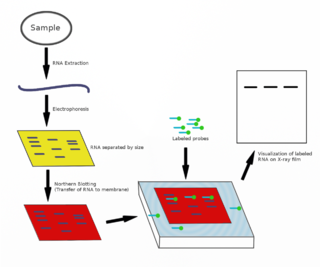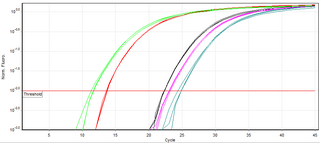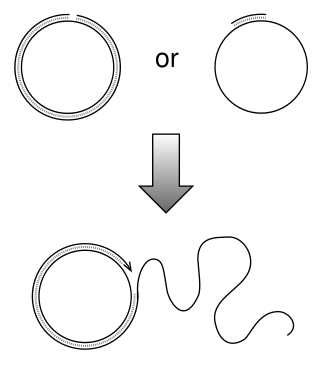Related Research Articles

In genetics, complementary DNA (cDNA) is DNA synthesized from a single-stranded RNA template in a reaction catalyzed by the enzyme reverse transcriptase. cDNA is often used to express a specific protein in a cell that does not normally express that protein, or to sequence or quantify mRNA molecules using DNA based methods. cDNA that codes for a specific protein can be transferred to a recipient cell for expression, often bacterial or yeast expression systems. cDNA is also generated to analyze transcriptomic profiles in bulk tissue, single cells, or single nuclei in assays such as microarrays, qPCR, and RNA-seq.
Molecular biology is a branch of biology that seeks to understand the molecular basis of biological activity in and between cells, including biomolecular synthesis, modification, mechanisms, and interactions.

The northern blot, or RNA blot, is a technique used in molecular biology research to study gene expression by detection of RNA in a sample.

The polymerase chain reaction (PCR) is a method widely used to make millions to billions of copies of a specific DNA sample rapidly, allowing scientists to amplify a very small sample of DNA sufficiently to enable detailed study. PCR was invented in 1983 by American biochemist Kary Mullis at Cetus Corporation. Mullis and biochemist Michael Smith, who had developed other essential ways of manipulating DNA, were jointly awarded the Nobel Prize in Chemistry in 1993.
Oligonucleotides are short DNA or RNA molecules, oligomers, that have a wide range of applications in genetic testing, research, and forensics. Commonly made in the laboratory by solid-phase chemical synthesis, these small fragments of nucleic acids can be manufactured as single-stranded molecules with any user-specified sequence, and so are vital for artificial gene synthesis, polymerase chain reaction (PCR), DNA sequencing, molecular cloning and as molecular probes. In nature, oligonucleotides are usually found as small RNA molecules that function in the regulation of gene expression, or are degradation intermediates derived from the breakdown of larger nucleic acid molecules.

Reverse transcription polymerase chain reaction (RT-PCR) is a laboratory technique combining reverse transcription of RNA into DNA and amplification of specific DNA targets using polymerase chain reaction (PCR). It is primarily used to measure the amount of a specific RNA. This is achieved by monitoring the amplification reaction using fluorescence, a technique called real-time PCR or quantitative PCR (qPCR). Confusion can arise because some authors use the acronym RT-PCR to denote real-time PCR. In this article, RT-PCR will denote Reverse Transcription PCR. Combined RT-PCR and qPCR are routinely used for analysis of gene expression and quantification of viral RNA in research and clinical settings.

A DNA microarray is a collection of microscopic DNA spots attached to a solid surface. Scientists use DNA microarrays to measure the expression levels of large numbers of genes simultaneously or to genotype multiple regions of a genome. Each DNA spot contains picomoles of a specific DNA sequence, known as probes. These can be a short section of a gene or other DNA element that are used to hybridize a cDNA or cRNA sample under high-stringency conditions. Probe-target hybridization is usually detected and quantified by detection of fluorophore-, silver-, or chemiluminescence-labeled targets to determine relative abundance of nucleic acid sequences in the target. The original nucleic acid arrays were macro arrays approximately 9 cm × 12 cm and the first computerized image based analysis was published in 1981. It was invented by Patrick O. Brown. An example of its application is in SNPs arrays for polymorphisms in cardiovascular diseases, cancer, pathogens and GWAS analysis. It is also used for the identification of structural variations and the measurement of gene expression.
In molecular biology, an amplicon is a piece of DNA or RNA that is the source and/or product of amplification or replication events. It can be formed artificially, using various methods including polymerase chain reactions (PCR) or ligase chain reactions (LCR), or naturally through gene duplication. In this context, amplification refers to the production of one or more copies of a genetic fragment or target sequence, specifically the amplicon. As it refers to the product of an amplification reaction, amplicon is used interchangeably with common laboratory terms, such as "PCR product."

A real-time polymerase chain reaction is a laboratory technique of molecular biology based on the polymerase chain reaction (PCR). It monitors the amplification of a targeted DNA molecule during the PCR, not at its end, as in conventional PCR. Real-time PCR can be used quantitatively and semi-quantitatively.

Rolling circle replication (RCR) is a process of unidirectional nucleic acid replication that can rapidly synthesize multiple copies of circular molecules of DNA or RNA, such as plasmids, the genomes of bacteriophages, and the circular RNA genome of viroids. Some eukaryotic viruses also replicate their DNA or RNA via the rolling circle mechanism.

Genetic analysis is the overall process of studying and researching in fields of science that involve genetics and molecular biology. There are a number of applications that are developed from this research, and these are also considered parts of the process. The base system of analysis revolves around general genetics. Basic studies include identification of genes and inherited disorders. This research has been conducted for centuries on both a large-scale physical observation basis and on a more microscopic scale. Genetic analysis can be used generally to describe methods both used in and resulting from the sciences of genetics and molecular biology, or to applications resulting from this research.
Digital polymerase chain reaction is a biotechnological refinement of conventional polymerase chain reaction methods that can be used to directly quantify and clonally amplify nucleic acids strands including DNA, cDNA, or RNA. The key difference between dPCR and traditional PCR lies in the method of measuring nucleic acids amounts, with the former being a more precise method than PCR, though also more prone to error in the hands of inexperienced users. A "digital" measurement quantitatively and discretely measures a certain variable, whereas an “analog” measurement extrapolates certain measurements based on measured patterns. PCR carries out one reaction per single sample. dPCR also carries out a single reaction within a sample, however the sample is separated into a large number of partitions and the reaction is carried out in each partition individually. This separation allows a more reliable collection and sensitive measurement of nucleic acid amounts. The method has been demonstrated as useful for studying variations in gene sequences — such as copy number variants and point mutations — and it is routinely used for clonal amplification of samples for next-generation sequencing.
The following outline is provided as an overview of and topical guide to genetics:

The history of the polymerase chain reaction (PCR) has variously been described as a classic "Eureka!" moment, or as an example of cooperative teamwork between disparate researchers. Following is a list of events before, during, and after its development:
The versatility of polymerase chain reaction (PCR) has led to modifications of the basic protocol being used in a large number of variant techniques designed for various purposes. This article summarizes many of the most common variations currently or formerly used in molecular biology laboratories; familiarity with the fundamental premise by which PCR works and corresponding terms and concepts is necessary for understanding these variant techniques.
Nucleic acid methods are the techniques used to study nucleic acids: DNA and RNA.
Wojciech Rychlik is a biologist and photographer, born in Poland and living in the USA since 1980. Rychlik received his Ph.D. in 1980 from the Polish Academy of Sciences. Currently, he is a president of Molecular Biology Insights, Inc. located in Cascade, Colorado.

MAGIChips, also known as "microarrays of gel-immobilized compounds on a chip" or "three-dimensional DNA microarrays", are devices for molecular hybridization produced by immobilizing oligonucleotides, DNA, enzymes, antibodies, and other compounds on a photopolymerized micromatrix of polyacrylamide gel pads of 100x100x20µm or smaller size. This technology is used for analysis of nucleic acid hybridization, specific binding of DNA, and low-molecular weight compounds with proteins, and protein-protein interactions.
Transcriptomics technologies are the techniques used to study an organism's transcriptome, the sum of all of its RNA transcripts. The information content of an organism is recorded in the DNA of its genome and expressed through transcription. Here, mRNA serves as a transient intermediary molecule in the information network, whilst non-coding RNAs perform additional diverse functions. A transcriptome captures a snapshot in time of the total transcripts present in a cell. Transcriptomics technologies provide a broad account of which cellular processes are active and which are dormant. A major challenge in molecular biology is to understand how a single genome gives rise to a variety of cells. Another is how gene expression is regulated.
This glossary of cellular and molecular biology is a list of definitions of terms and concepts commonly used in the study of genetics and related disciplines in biology, including molecular biology, cell biology, and evolutionary biology. It is intended as introductory material for novices; for more specific and technical detail, see the article corresponding to each term. For related terms, see Glossary of evolutionary biology.
References
- ↑ John SantaLucia, Jr. (2007) Basic Principles and Software for PCR Primer Design: Physical Principles and Visual-OMP Software for Optimal PCR Design, in Methods in Molecular Biology Vol. 402: PCR Primer Design; Ed. A. Yuryev; Humana Press Inc., Totowa, NJ. pp. 3-33.
- ↑ John D. Offerman, Wojciech Rychlik (2003) Oligo Primer Analysis Software in Introduction to bioinformatics: a theoretical and practical approach. Ed. Stephen A. Krawetz and David D. Womble; Humana Press Inc., Totowa, NJ. pp. 345-361.
- ↑ Wojciech Rychlik and Robert E. Rhoads (1989) A Computer Program for Choosing Optimal Oligonucleotides for Filter Hybridization, Sequencing and in vitro Amplification of DNA; Nucleic Acids Research 17, 8543-8551.
- ↑ Arneth Borros (2009) Following Ionic Activity by Electrochemistry During the Polymerase Chain Reaction; Analytical Biochemistry 385, 26-33.
- ↑ Arabinda Das, Naren L. Banik, and Swapan K. Ray (2008) Modulatory Effects of Acetazolomide and Dexamethasone on Temozolomide Mediated Apoptosis in Human Glioblastoma T98G and U87MG Cells; Cancer Investigation 26, 352 - 358.
- ↑ Sarah H. Haddock, Christine Quartararo, Patrick Cooley, and Dat D. Dao (2002) Low-Resolution Typing of HLA-DQA1 Using DNA Microarray, Methods in Molecular Biology 170, 201-210.
- ↑ Marco Severgnini, Paola Cremonesi, Clarissa Consolandi, Giada Caredda, Gianluca De Bellis and Bianca Castiglioni (2009) ORMA: a tool for identification of species-specific variations in 16S rRNA gene and oligonucleotides design; Nucleic Acids Research 37 (16), e109.
- ↑ Arhat Abzhanov (2009). "Darwin's Finches: Analysis of Beak Morphological Changes During Evolution". Cold Spring Harbor Protocols. 1 (3): 481–500. doi:10.1101/pdb.emo119. PMID 20147092.
- ↑ Canhui Liu, Chitra Chauhan, Charles R. Katholi, and Thomas R. Unnasch (2009) The splice leader addition domain represents an essential conserved motif for heterologous gene expression in B. malayi; Molecular & Biochemical Parasitology 166, 15–21.
- ↑ Daryl A. Scott, Merel Klaassens, Ashley M. Holder, Kevin P. Lally, Caraciolo J. Fernandes, Robert-Jan Galjaard, Dick Tibboel, Annelies de Klein, and Brendan Lee (2007) Genome-Wide Oligonucleotide-Based Array Comparative Genome Hybridization Analysis of Non-Isolated Congenital Diaphragmatic Hernia; Human Molecular Genetics. 16, 424-430.
- ↑ Omar J. Jabado, Gustavo Palacios, Vishal Kapoor, Jeffrey Hui, Neil Renwick, Zhai Junhui, Thomas Briese, and W. Ian Lipkin (2006) Greene SCPrimer: a Rapid Comprehensive Tool for Designing Degenerate Primers from Multiple Sequence Alignments; Nucleic Acids Research. 34, 6605-6611.
- ↑ Alberto Arias, Ruth Freire, Josefina Méndez, and Ana Insua (2010) Isolation and characterization of microsatellite markers in the queen scallop Aequipecten opercularis and their application to a population genetic study; Aquatic Living Resources 23, 199 - 207.
- ↑ Frédérique Bidard, Sandrine Imbeaud, Nancie Reymond, Olivier Lespinet, Philippe Silar, Corinne Clavé, Hervé Delacroix, Véronique Berteaux-Lecellier and Robert Debuchy (2010) A general framework for optimization of probes for gene expression microarray and its application to the fungus Podospora anserina; BMC Research Notes 3, 171.
- ↑ Kazutaka Yamada, Takeshi Terahara, Shinya Kurata, Toyokazu Yokomaku, Satoshi Tsuneda, and Shigeaki Harayama (2008) Retrieval of Entire Genes from Environmental DNA by Inverse PCR with Pre-Amplification of Target Genes Using Primers Containing Locked Nucleic Acids; Environmental Microbiology 10, 978 - 987.
- ↑ Tokuji Tsuchiya; Nanako Kameya & Ikuo Nakamura (2009). "Straight Walk: A modified method of ligation-mediated genome walking for plant species with large genomes". Analytical Biochemistry. 388 (1): 158–160. doi:10.1016/j.ab.2009.02.002. PMID 19454221.
- ↑ O. A. Gra, A. S. Glotov, Zh. M. Kozhekbayeva, O. V. Makarova, and T. V. Nasedkina (2008) Genetic Polymorphism of GST, NAT2, and MTRR and Susceptibility to Childhood Acute Leukemia; Molecular Biology 42, 187-197.
- ↑ T. Wei, G. Lu, and G. R. G. Clover (2009) A Multiplex RT-PCR for the Detection of Potato Yellow Vein Virus, Tobacco Rattle Virus and Tomato Infectious Chlorosis Virus in Potato with a Plant Internal Amplification Control; Plant Pathology 58, 203-209.
- ↑ Kristel Van Laethema, Yoeri Schrootena, Kris Covensa, Nathalie Dekeersmaekera, Paul De Munterc, Eric Van Wijngaerdenc, Marc Van Ransta, and Anne-Mieke Vandamme (2008) A Genotypic Assay for the Amplification and Sequencing of Integrase from Diverse HIV-1 Group M Subtypes; Journal of Virological Methods 153, 176-181.
- ↑ Elena K. Khlestkina, Uttam Kumar, and Marion S. Röder (2010) Ent-kaurenoic acid oxidase genes in wheat; Molecular Breeding 25, 251–258.
- ↑ Guozheng Conga, Jianhua Zhoua, Shandian Gaoa, Junzheng Dua, Junjun Shaoa, Tong Lina, Huiyun Chang, and Qingge Xie (2008) Construction of Recombinant Retroviral Vector Carrying Lab Gene of Foot-and-Mouth Disease Virus and Its Expression in Bovine Kidney (MDBK) Cells; Chinese Journal of Biotechnology 24, 740-745.
- ↑ Lei Wei, Xiaobing Wu, and Zhigang Jiang (2009) The complete mitochondrial genome structure of snow leopard Panthera uncia; Molecular Biology Reports 36, 871–878.
- ↑ David S. Perlin, Sergey Balashov, and Steven Park (2008) Multiplex Detection of Mutations; Methods in Molecular Biology 429, 23-31.
- ↑ Michele Salemi, Corrado Romano, Concetta Barone, Francesco Cali, Filippo Caraci, Carmelo Romano, Cataldo Scavuzzo, Francesco Scillato, Maria Grazia Salluzzo, Maria Piccione, Manuela Martines, Giovanni Corsello, Ferdinando Nicoletti, and Paolo Bosco (2009) SPANX-B and SPANX-C (Xq27 region) gene dosage analysis in Down’s syndrome subjects with undescended testes; Journal of Genetics 88, 93-97.
- ↑ Anastasia Khvorova, Angela Reynolds, and Sumedha D. Jayasena (2003) Functional siRNA and miRNAs Exhibit Strand Bias; Cell, 115, 209-216.
- ↑ Rossanna C. Pezo, Saumil J. Gandhi, L. Andrew Shirley, Richard G. Pestell, Leonard H. Augenlicht, and Robert H. Singer (2008) Single-Cell Transcription Site Activation Predicts Chemotherapy Response in Human Colorectal Tumors; Cancer Research 68, 4977-4982.
- ↑ Rachael Carters, Jennifer Ferguson, Rupert Gaut, Paul Ravetto, Nicola Thelwell, and David Whitcombe (2008) Design and Use of Scorpions Fluorescent Signaling Molecules; Methods in Molecular Biology 429, 99-115.
- ↑ Chunsun Zhang and Da Xing (2010) Microfluidic gradient PCR (MG-PCR): a new method for microfluidic DNA amplification; Biomedical Microdevices 12, 1-12.